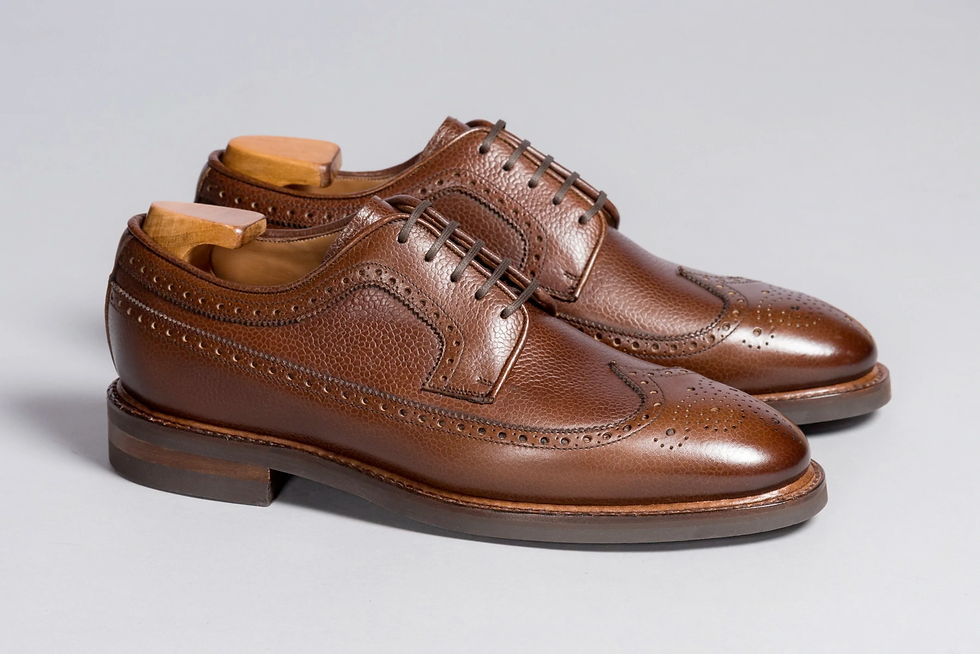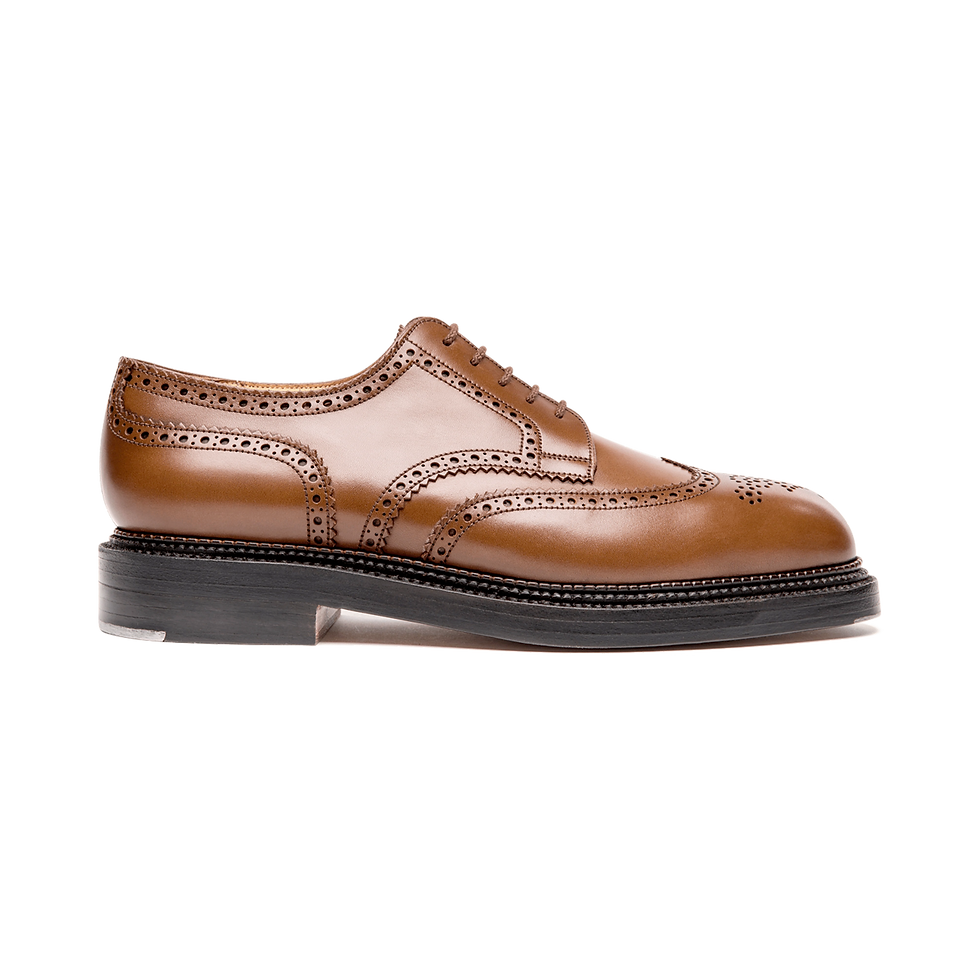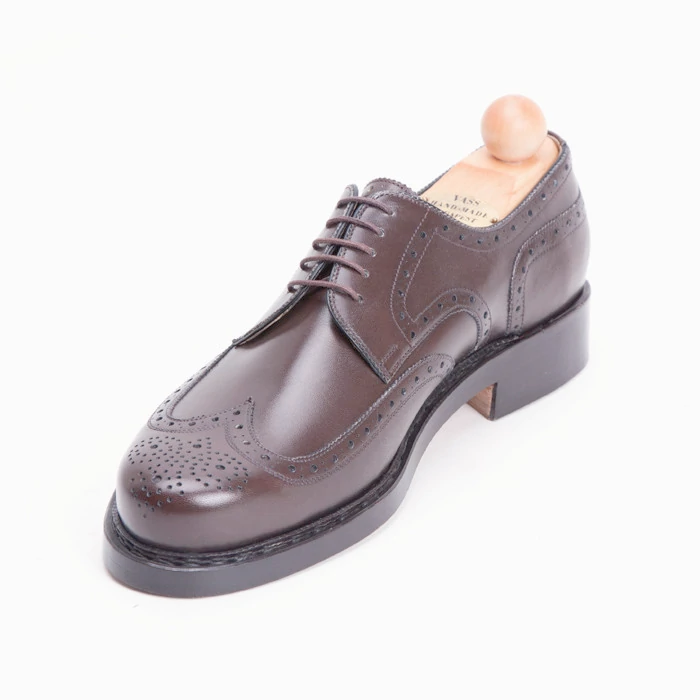The Shoe Styles I've Known of: Full Brogue Derbies
- Alexander Dylan Thomas
- Feb 14, 2022
- 10 min read
Updated: Nov 10, 2022

Naming conventions for male footwear can at times be highly ambiguous. What one manufacturer may refer to as a full-brogue derby might equally be referred to as a long-wing Blucher by another.
As the potential designs for such a shoe are nearly limitless, this article will refer to the two paragons of this Pan-Atlantic full-brogue kingdom; the wing-tip brogue and the long-wing blucher, both constructed with ‘open’ lacing.
The wing-tip is primarily a design associated with the British Isles and has a long history of wear by country folk looking for sturdy shoes that accommodate moist conditions and long walks. They are defined by the wing-like designs on their toe caps, and classic derby quarters. Most British manufacturers offer some form of this classic shoe (seen in the title image) and they form an integral component of the country-inspired le style Anglaise.
The long-wing is a uniquely North-American design, which took the classic wingtip design and stretched the forward wing portions to the rear seam, and in so doing moved the facing higher up the vamp in the ‘Blucher’ style. This design was made famous by the Florsheim house, and original ‘gunboat brogues’ from the marques’ earlier days of manufacture are fetishized by lovers of the style worldwide.

From an environmental perspective, the full brogue derby is in a class of its own. Timelessly stylish - or perhaps timelessly un-stylish you might say – it defies association with a particular time or period, and thus enters the pantheon of truly enduring styles.
They are typically heavily constructed of grained or pebbled leathers and have many adornments that allow the utilization of the full hide. It is often said that a pair of full brogues are a clickers’ dream, but a closers’ nightmare. Goodyear or Norwegian welting is de rigueur to ensure the correct levels of waterproofing and comfort for country tramps.
Double leather or lugged rubber soles add extra layers of protection and durability. Such soles also make walking in any conditions a pleasure, which may, in turn, minimize reliance on other more resource-intensive forms of transport.
There exist many reports of this style of shoe lasting well beyond fifty years of wear, and the healthy market for vintage Florsheim Imperial models attests to this fact. Given their widespread popularity and availability, many fantastic options exist for shoe lovers of all budgets.
Attainable
The first price bracket is under $400 USD full retail. It is actually quite challenging for shoemakers to present shoes of high-quality materials, with a goodyear-welted construction, and full leather linings for this budget. Those that are able to do so consistently should be commended. Companies are able to achieve this through some combination of scale (Allen Edmonds), the slightly lower labour costs of production in China, India, Portugal, or Spain (Löf & Tung), or some combination of both (Loake 1880 line).
Option 1. Löf & Tung Irwin

A very handsome take on the classic long-wing design, the Irwin shoe sits atop Dainite soles and sleek storm welts, providing high levels of water-resistance and comfort. The shoe is fully leather lined and is constructed of French full-grain leather embossed with a ‘country grain’ pattern, probably from Tanneries du Puy.
The making of this shoe occurs in the Almansa region of Spain, which has long been associated with fine footwear. It is built upon the T last, which is a subtly almond-shaped last, lending a touch of elegance to what can be a very rustic shoe. The mahogany colour is also very versatile, being of a mid-brown variety, and would reward the application of different polishes with an individual patina over time.
This visual texture of this shoe would sit perfectly under a pair of brown medium-wale corduroys, mustard socks, a navy polo neck sweater, and an olive green waxed cotton jacket for a stroll in the countryside.
Option 2. Loake 1880 Badminton

The Loake Badminton is a classically styled British country shoe, as befits a Northamptonshire heritage brand. Again, a grained leather sits atop a Dainite sole for unquestionable weather resistance. Unlike the rubber midsole and sleek welt of the Irwin, the Badminton proffers a very hefty storm welt, and a leather mid-sole, which will slightly conform to the wearers’ foot over time.
Other rustic details include the exposed metal eyelets and the rounder 026 last, which can also be found in a wide G fitting. The pattern details of this shoe also conform to the more British style of Derby facing and a closed ‘wingtip’. At this price point, both grained and suede leathers offer fantastic value over finer smooth calf skins due to their inherently thicker and more robust nature. With the construction methods used, and the ability to re-craft the shoes on the original assembly line, these shoes could last the best part of a century.
While the very chunky and rustic styling of this shoe may not appeal to all, this shoe’s British-made pedigree is a perfect fit for this style, and could work with a Norwegian fisherman's sweater, pink oxford shirt, tan cavalry twill trousers, and chunky socks.
Option 3. Allen Edmonds Macneil

Here we have another classic long-wing blucher from the storied All-American footwear manufacturer Allen Edmonds. This model departs from the use of grained leathers and Dainite soles by utilizing a very beautiful shade of smooth mahogany calfskin on the upper, and double-oak soles.
This presents an altogether different shoe, one that might not be out of place under a tan cotton suit in summer, with a white dress shirt, mid-brown knit tie, and tan socks. Such a shoe still presents an attractive proposition for long walks in varied conditions with its storm welt and sturdy construction but sacrifices the extra weather-proofing of a rubber sole for a higher ability to conform to the wearer's foot in the long term.
It must be noted that Allen Edmonds has seemingly lowered manufacturing standards to maintain regular sales of their footwear in recent years. This technique has led to many in the footwear community to abandon the brand entirely. It may be worth seeking these shoes in person to avoid potential problems, and waiting for semi-regular sales to purchase at a price that more accurately reflects the quality of construction.
Advanced
The next shoe propositions range from $400-800 USD. In this price bracket, you should be expecting the finest materials, sturdy Goodyear construction, crafted with utmost attention to detail. They are still very much ‘bench-made’ shoes, in the sense that although worked on by very skilled artisans, they are made on what is essentially an assembly line.
But do not let this deter you, as the machinery operated by these craftspeople can in fact rival - and sometimes exceed - the precision and detail of bespoke makers. The names of the manufacturers of these next shoe offerings will be familiar to all with even a passing knowledge of fine footwear.
Option 1. Alden Longwing 97877C in Chromexcel

For aficionados of US-made footwear, Alden holds the torch as the quintessential American heritage footwear brand. Seasoned sartorialists look to the marque to provide a visual anchor to outfits consisting of lightweight Italian tailoring. The fashion house Drakes’ look-books provides innumerable examples of this done very well.
This shoe is built on the classic Barrie last which is a very rounded and high-volume last, with large ‘pre-stitched’ reverse welts and ‘commando’ lugged sole. This sole provides the long-term comfort and flexibility of a double leather sole while providing the traction and wear-resistance of a rubber sole. This is particularly evident at the toe, a common point of high-wear in traditional leather soles.
Another clever feature is the use of Chromexcel leather. This leather - produced by the famous Horween Tannery in Chicago – undergoes a dual chrome and vegetable tanning process that leads to a high residual oil content in the leather. This greasy leather will age beautifully over the years and develop a unique patina with minimal maintenance.
The informal leather and rounder design would suit being worn with dark denim jeans, a blue oxford shirt, unstructured tan plaid sports coat, and forest green socks for a comfortable off-duty but still put-together outfit.
Option 2. Crockett & Jones Pembroke

Heralded as the original ‘gentleman farmer’ style, this shoe can be found on the feet of elegant Milanese, impeccably dressed Japanese, and trendy New Yorkers alike. Although it can also be sighted in its’ original home-place in the British countryside, this style has truly become a global style phenomenon, as befits its’ subtle but unique charms.
First is the last, as the old shoe-making pun goes. In this case the 325 last, a beautifully curvaceous round-toed last that adds increased toe depth and a clipped heel. This last is the true secret ingredient of this shoe, as it perfectly treads the line between casual and elegant, that elusive combination that so suits the modern style milleu.
The ‘tan’ scotch grain upper also leans heavily towards the darker ‘British’ tan end of the spectrum, allowing the shoes to have a visual presence, but to remain highly wearable in most situations. Again, a Crockett & Jones-branded Dainite sole rounds out the package. For proof of their longevity, read here of a forty-year-old pair of Pembrokes still performing admirably.
This shoe would work beautifully with a rough tweed suit in mossy green and heather brown and a tattersall shirt, perhaps with royal purple socks and purple ancient madder tie for a touch of tonal dissonance.
Option 3. Carmina 532 Detroit in Armagnac Cordovan

Spanish maker Carmina consistently provides shoes of elevated quality and materials for prices that undercut other manufacturers' standard offerings. Such is the case in this beautiful shoe.
Departing from the chunky and perhaps unrefined shapes of traditional brogues, these longwings push more into the dress shoe category with the narrower and elongated Detroit last, Joh Rendenbach soles with closed-channel stitching and intricate sole fudging. Another high-end feature is the upper material, which is the highly sought-after Armagnac Cordovan from the Horween Tannery.
The incredible longevity of this leather is widely seen in the vintage shoes available on auction sites from the fifties and sixties. The Armagnac colour also increases the versatility of this shoe, more easily moving up and down the formality spectrum than the traditional ‘colour 8’.
The combination of these factors makes these shoes a stellar offering from a marque whose history actually predates the invention of the Goodyear welt. The sleeker lines of this shoe would suit a more business-appropriate pairing of grey glen plaid suit, charcoal grenadine tie, blue and white Bengal stripe shirt, and grey socks.
Aspirational
Shoes costing over $800 USD may not actually present a longer lifespan than shoes in the lower price brackets. They will however provide a myriad of details that are not possible at a lower price point. These details may include the finest possible leathers, hand-welting, hand-lasting, and attention to detail.
One should expect that shoes at this level to not just be comfortable and look great, but also be wearable works of art. This said, beauty is oft in the eye of the beholder, and in the upper echelons of footwear, one might encounter more polarizing and daring designs.
Option 1. JM Weston Triple Sole Derby

The venerable JM Weston occupies the pole position for fine French factory-produced footwear. They are also a maker that - while also producing very stylistically conservative shoes - are unafraid to be adventurous with many of their designs.
The triple-soled beast before you is one such shoe. Made with three layers of oak-bark tanned leather, replete with metal toe and heel taps, and stitched onto incredibly wide and robust storm welts, this shoe is a veritable tank. The solidity of the lowers is somehow balanced by the relatively sleek and unadorned uppers. Produced in a mid-brown boxcalf, they boast a somewhat slim almond-shaped last and almost restrained details.
Adding to the brands’ environmental credentials is the existence of Weston Vintage, a JM Weston-owned online marketplace for used shoes, where old pairs are restored in the original factory to former glory and presented for sale to prospective owners.
The massive soles on these shoes could really only be worn in a casual setting. For such visually heavy shoes, a pair of olive green chinos, white rugby shirt and brushed grey Shetland sweater and wool socks could provide an appropriate level of rusticity.
Option 2. Vass Budapester

Here we enter the realms of the truly hand-constructed shoe. With the storied Hungarian maker Laszlo Vass - who literally wrote the book on handmade shoes (borrow it free here) - you can be assured that the best methods of construction available have been employed in the making of this shoe.
This shoe is the classic Budapester model, and although the design may have originally been inspired from English shoes, they have developed over the years into having very much their own design language. This language incorporates a very roomy, almost bulbous toe box, thick German oak double soles, and most notably, a Goyser welt connecting the upper to the outsole. This welt is very similar to the Norwegian welt often found on handmade Italian shoes and shares its’ incredible water resistance.
The level of handcrafting involved in this shoe is a testament to the skills maintained in Hungary, even through the Communist years, where the cottage industry was allowed to continue in small workshops lining the streets of Budapest. Modern shoe lovers can thank the lenient oblast secretariat that these unique and iconic shoes are still made in much the same way now.
Again this last would suggest a highly informal shoe, but in native Hungary, these shoes are worn as part of a business uniform. In light of this, the outfit recommendation might be a dark grey flannel suit, pale pink shirt, and burgundy wool tie and socks for a winter workday.
Option 3. Edward Green Sandringham

Moving from the double and triple welts of the previous shoes, here we encounter the almost unthinkably sleek full brogue derby by Edward Green. Departing with tradition - and the double sole - the Sandringham cuts a far more elegant profile than any brogue thus investigated.
As is often the case with this marque, what initially seems an unimpressive and unassuming design begins to truly impress upon closer examination. First, one notices the subtle, but beautiful scotch thistle design on the quarters. Then, the finely balanced upper patterning and last shape become more apparent. Then the final coup de grace, the aforementioned single oak sole bringing this shoe into a whole new world of business wear-ability.
With a darker patina on the toe and heel, this shoe could be worn with an air force blue flannel suit, white shirt, navy grenadine tie, and navy socks. If that very British notion of sophistication through subtlety appeals to you, these shoes might well be your partners for life.
conclusion
As can be seen from the range of full brogue derbies examined here, the options available for all price ranges offer several unique perspectives on these classic designs. While the long-wing and wing-tip are quintessentially Anglo-American designs, the Spanish, French and Hungarian makers all add something unique and special to the basic format.
All of these shoes will reward careful brushing, conditioning, and polishing. The shoes constructed of cordovan and Chromexcel will require significantly less nourishing than the calf shoes.
Given the range of browns presented, these shoes present an enormous opportunity for the creation of a custom patina, lovingly applied over the years. To do so, every couple polishes, change the colour of the polish applied. Use a slightly darker polish on the heel and toe counters. You can even take the entire colour of the shoe in a new direction by perhaps using mahogany polish on a mid-brown shoe, or burgundy polish on a chocolate-brown shoe.
Such are the pleasures of fine footwear, they will become more uniquely yours over time, trusted companions on the journey of life.
The next article in this series will examine another Anglo-American casual classic — the penny loafer.

Disclaimer: Any views represented in this article belong solely to the author and may not represent those of the blog owner. This article is not sponsored by any brands.
Photography: as stated



Comments